
In firearm designs, the term single-shot refers to guns that can hold only a single round of ammunition inside and thus must be reloaded manually after every shot. Compared to multi-shot repeating firearms ("repeaters"), single-shot designs have no moving parts other than the trigger, hammer/firing pin or frizzen, and therefore do not need a sizable receiver behind the barrel to accommodate a moving action, making them far less complex and more robust than revolvers or magazine/belt-fed firearms, but also with much slower rates of fire.
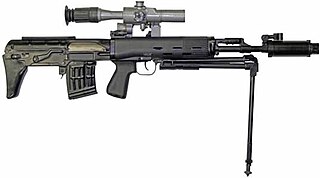
A bullpup firearm is one with its firing grip located in front of the breech of the weapon, instead of behind it. This creates a weapon with a shorter overall length for a given barrel length, and one that is often lighter, more compact, concealable and more maneuverable than a conventionally configured firearm. Where it is desirable for troops to be issued a more compact weapon, the use of a bullpup configuration allows for barrel length to be retained, thus preserving muzzle velocity, range and ballistic effectiveness.

The .50 BMG, also known as 12.7×99mm NATO, and designated as the 50 Browning by the C.I.P., is a .50 in (12.7 mm) caliber cartridge developed for the M2 Browning heavy machine gun in the late 1910s, entering official service in 1921. Under STANAG 4383, it is a standard service cartridge for NATO forces, as well as many non-NATO countries. The cartridge itself has been made in many variants: multiple generations of regular ball, tracer, armor-piercing (AP), incendiary, and saboted sub-caliber rounds. The rounds intended for machine guns are made into a continuous belt using metallic links.
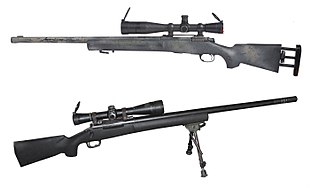
A sniper rifle is a high-precision, long-range rifle. Requirements include high accuracy, reliability, and mobility, concealment, and optics, for anti-personnel, anti-materiel and surveillance uses by military snipers. The modern sniper rifle is a portable shoulder-fired rifle with either a bolt action or semi-automatic action, fitted with a telescopic sight for extreme accuracy and chambered for a high-ballistic performance centerfire cartridge.
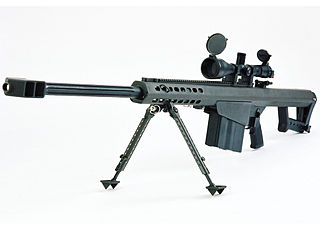
An anti-materiel rifle (AMR) is a rifle designed for use against military equipment, structures, and other hardware (materiel) targets. Anti-materiel rifles are chambered in significantly larger calibers than conventional rifles and are employed to eliminate equipment such as engines and unarmored or lightly armored targets. While modern armored vehicles are resistant to anti-materiel rifles, the extended range and penetration still has many modern applications. While not intended for use against human targets, the bullet weight and velocity of anti-materiel rifles gives them exceptional long-range capability even when compared with designated sniper rifles. Anti-materiel rifles are made in both bolt-action as well as semi-automatic designs.
The Accuracy International Arctic Warfare rifle is a bolt-action sniper rifle designed and manufactured by the British company Accuracy International. It has proved popular as a civilian, police, and military rifle since its introduction in the 1980s. The rifles have some features that improve performance in very cold conditions without impairing operation in less extreme conditions.

The Barrett M82 is a recoil-operated, semi-automatic anti-materiel rifle developed by the American company Barrett Firearms Manufacturing.
The CheyTac Intervention also known as the CheyTac M200, is an American bolt-action sniper rifle manufactured by CheyTac USA, which can also be classified as an anti-materiel rifle. It is fed by a seven-round detachable single-stack magazine. It is specifically chambered in either .408 Chey Tac or .375 Chey Tac ammunition. CheyTac Inc. states that the system is capable of delivering sub-MOA accuracy at ranges of up to 2,500 yd (2,286 m). It is based on the EDM Arms Windrunner.

The Bor is a Polish bolt-action 7.62×51mm NATO and .338 Lapua Magnum caliber sniper rifle. The weapon received the code name Alex during development, after the name of the lead designer Aleksander Leżucha, creator of the 12.7×99mm NATO Wilk anti-materiel rifle. After the development phase, the rifle received the military designation 'Bor'.

The Barrett M99 is a single-shot anti-materiel rifle that was first introduced in 1999 by the Barrett Firearms Company as a less expensive alternative to the company's higher-priced offerings. The rifle uses a bullpup configuration with a pistol grip.
The Gepárd anti-materiel rifles are a family of Hungarian weapons manufactured by Sero International designed to destroy unarmored and lightly armored targets. These long-range large-caliber rifles have high accuracy and muzzle velocity. In 1987, the Hungarian People's Army sought to obtain a compact, mobile weapon that could damage lightly armored targets. The project, led by Ferenc Földi, culminated in the creation of the Gepárds.
The .408 Cheyenne Tactical is a specialized rimless, bottlenecked, centerfire cartridge for military long-range sniper rifles that was developed by Dr. John D. Taylor and machinist William O. Wordman. The round was designed with a possible military need for a cartridge for anti-personnel, anti-sniper, and anti-materiel roles with a (supersonic) precision range of 2,200 yards. It is offered as a competitor to the most common military NATO long-range service cartridges such as .338 Lapua Magnum and the .50 BMG.
The .416 Barrett, also known as 10.4×83mm, centerfire rifle cartridge is a proprietary bottlenecked centrefire rifle cartridge designed in 2005. It is an alternative to the large-caliber .50 BMG in long-range high-power rifles. It was designed in response to a request for a medium/heavy rifle cartridge combination that was issued from Naval Surface Warfare Center Crane Division in late 2004.

The DSR-1 is a compact bolt-action sniper rifle designed, manufactured and marketed by the German company DSR-Precision GmbH and was also marketed by the German company AMP Technical Services as a specialized sniper rifle for police sharpshooters. It has been adopted by the German counter-terrorist unit GSG 9, as well as by other European special police units and agencies.
The Barrett M90 is a bolt-action, bullpup rifle chambered in .50 BMG. It was designed and manufactured by Barrett Firearms Company. In 1995, Barrett stopped production of the M90, and replaced it with the M95.
The Desert Tech Stealth Recon Scout (SRS) is a bolt-action sniper rifle developed by the Utah-based firearm manufacturer Desert Tech. It was unveiled at the 2008 SHOT Show. It is known for its bullpup design.
The DSR-Precision DSR-50 is a bullpup bolt-action anti-materiel rifle developed and manufactured by DSR-Precision GmbH and chambered in .50 BMG. It is essentially an upscaled DSR-1.
The ZVI Falcon is a Czech 12.7 mm caliber bolt-action bullpup anti-materiel rifle developed by Zbrojovka Vsetín Inc.. The rifle is intended for ground troops and special forces for operations against distant targets up to 1,600 metres (1,700 yd) away, such as armoured fighting vehicles (AFVs) or technical equipment.
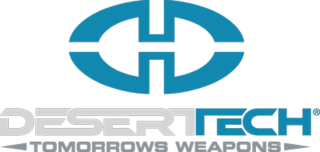
Desert Tech is an American munitions manufacturer. The company is financed and owned by members of the Kingston family and primarily produces bullpup rifles.
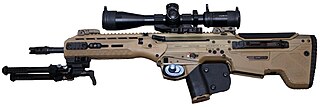
The MDR is a family of autoloading bullpup rifles designed by Desert Tech in 2014. A second generation version of the rifle is marketed as the MDRX. In 2018 a military version of the MDR, the NGSAR, was submitted, but was not one of the finalists in the United States Army Next Generation Squad Weapon Program trials to replace standard issue US army Infantry Weapons.












